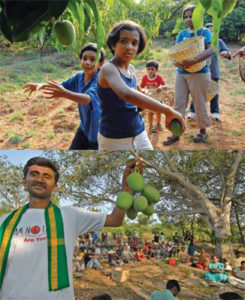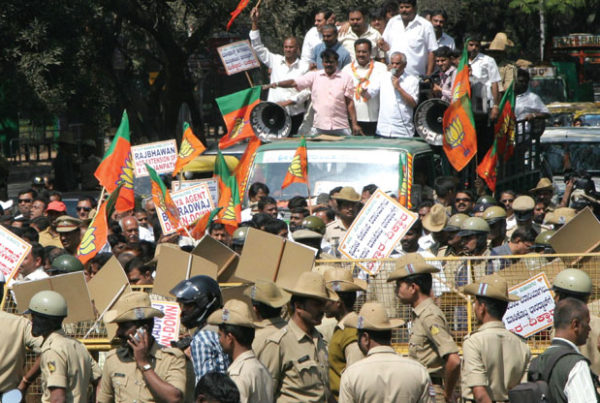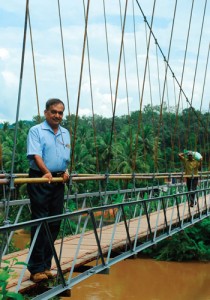Organic food could soon find its way from super marts to the plate of commoners, finds Sanjana Chappalli
 Trophy pickings: Surendra proudly displays his crop (above), while kids choose mangoes at his orchard. Photo: S RADHAKRISHNA
Trophy pickings: Surendra proudly displays his crop (above), while kids choose mangoes at his orchard. Photo: S RADHAKRISHNACHEMICAL FERTILIZERS are like alcohol — the more you use them, the more addicted the soil becomes. And of course, the less productive are its yields,” says Surendra Ramakrishnappa. On a lazy Sunday afternoon, at his mango orchard, 60 km outside Bengaluru, Surendra is talking of the consequences of using chemicals to grow crops. Since his shift to traditional organic farming practices, he has had a bumper mango crop this year.
About 100 people from Bengaluru have gathered at Surendra’s 11-acre orchard to participate in a Mango Fest — a programme put together by Samvada, a 20-year-old NGO that is now promoting organic farming amongst farmers and consumers. Mango Fest was held to showcase the bumper yields of Ramakrishnappa and 20 other farmers who went organic. Says Benson Issac, director of Samvada’s livelihood programme, “Our attempt was to encourage young people to take up livelihoods that contribute to environmental and social change. But we found the need to cover political and conceptual ground before we could convince farmers about the advantages of organic farming.” He explains that by abandoning expensive chemical fertilizers and switching to organic fertilizers the greatest advantage to a farmer is that of costs.
“Using chemicals like urea and phosphate and DDT does give an increased yield. But this is only for the first three years,” says Shivannapura Ramesh, a farmer from Devanahalli. Reminiscing about the traditional practices that his family followed, Ramesh is categorical of his move to organic farming as a step back in time. On his 11-acre farm just outside Bengaluru, Ramesh now grows a variety of vegetables and cereals.
Consider how 90 percent of the mangoes in the market are grown today. Having used chemical fertilizers in the past, Ramesh is happy to explain the procedure. “First a cocktail of pesticides including urea, DDT and super phosphate is sprayed during the flowering season. It is followed by an injection of pesticide directly into the tree to hasten the growth of the fruit. Later, the mangoes are ripened with the help of smoke and carbide. This makes the mangoes look superior, though I cannot say the same about the taste.” Both carbide and DDT, amongst a host of other chemical fertilizers used in India, are banned outside the country.
Is organic farming a possible solution to the deepening agricultural crises that India faces? “From every perspective, it presents a better alternative for the farmers and for the agricultural industry on the whole. But that does not mean we can do away with government intervention and support,” explains Divya Raghunandan, an anti-genetic engineering campaigner with Greenpeace. Even a quick glimpse at budgetary allocations supports Raghunandan’s argument. In 2007-08, the Indian government spent nearly Rs 22,450 crore on chemical fertilizer subsidy while it spent Rs 400 crore on organic farming subsidy. In the transitional period from chemical to organic farming, the yields from the land are hardly enough to sustain the farmer. Government intervention through adequate support prices during this period can make all the difference.
MANGOES ARE RIPENED WITH CARBIDE AND DDT, BOTH OF WHICH ARE BANNED OUTSIDE INDIA
Despite several advantages, organically grown crops are looked upon as the prerogative of the rich. On-the-shelf prices of most organically grown fruits and vegetables see a 10-15 percent markup compared to the rest. The mark-up is attributed to the expensive certification process to be certified as ‘organic’. Unlike the ISO quality certification, it is a complicated and confusing affair with a variety of certification companies vying to do the job. Typically, costs vary anywhere from Rs 500 to Rs 15,000 per day of inspection, depending on the complexities and the levels of testing involved. In the absence of trust and interactions between the consumer and the farmer, these certifications are considered indispensable. In reality, they translate into an expensive affair both for the farmer and the consumer. To save costs, attempts have now emerged to introduce peer certification — a process that sees farmers certifying each other based on an examination of the soil, the land, the crops and the process. “If there is a way to directly interact with the farmers, what can the motivation be for consumers to not trust them? Will some company’s stamp make more sense than the person they know?” asks Issac.
While direct interactions between farmers and consumers is the way forward, it would also bring about an environmental and social consciousness. On the anvil are ‘organic bazaars’ to be held in Bengaluru twice a month that will facilitate the interactions better. “The dream is to see organically grown fruits and vegetables in neighbourhood shops and with push cart vendors,” smiles Issac.
—
This article was originally published in Tehelka, a leading independent news magazine in India, known for its investigative journalism.



